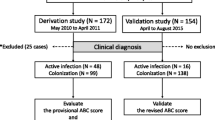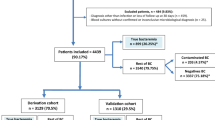Abstract
Infectious diseases specialists often use diagnostic tests to assess the probability of a disease based on knowledge of the diagnostic properties. It has become standard for published studies on diagnostic tests to report sensitivity, specificity and predictive values. Likelihood ratios are often omitted. We compared published clinical prediction rules in Staphylococcus aureus bacteremia to illustrate the importance of likelihood ratios. We performed a narrative review comparing published clinical prediction rules used for excluding endocarditis in S. aureus bacteremia. Of nine published clinical prediction rules, only three studies reported likelihood ratios. Many studies concluded that the clinical prediction rule could safely exclude endocarditis based on high sensitivity and high negative predictive value. Of the studies with similar high sensitivity and high negative predictive value, calculated negative likelihood ratios were able to differentiate and identify the best clinical prediction rule for excluding endocarditis. Compared to sensitivity, specificity and predictive values, likelihood ratios can be more directly used to interpret diagnostic test results to assist in ruling in or ruling out a disease. Therefore, a new standard should be set to include likelihood ratios in reporting of diagnostic tests in infectious diseases research.

Similar content being viewed by others
References
Sackett DL, Haynes RB, Tugwell P (1985) Clinical epidemiology: a basic science for clinical medicine, 1st edn. Little, Brown and Company, Boston
Bossuyt PM, Reitsma JB, Bruns DE et al (2003) The STARD statement for reporting studies of diagnostic accuracy: explanation and elaboration. Ann Intern Med 138(1):W1–12
U. S. Food and Drug Administration (FDA) (2015) Statistical guidance on reporting results from studies evaluating diagnostic tests. http://www.fda.gov/MedicalDevices/DeviceRegulationandGuidance/GuidanceDocuments/ucm071148.htm. Accessed 28 November 2015
Fowler VG Jr, Li J, Corey GR et al (1997) Role of echocardiography in evaluation of patients with Staphylococcus aureus bacteremia: experience in 103 patients. J Am Coll Cardiol 30:1072–1078
Incani A, Hair C, Purnell P et al (2013) Staphylococcus aureus bacteraemia: evaluation of the role of transoesophageal echocardiography in identifying clinically unsuspected endocarditis. Eur J Clin Microbiol Infect Dis 32:1003–1008
Joseph JP, Meddows TR, Webster DP et al (2013) Prioritizing echocardiography in Staphylococcus aureus bacteraemia. J Antimicrob Chemother 68:444–449
Kaasch AJ, Fowler VG Jr, Rieg S et al (2011) Use of a simple criteria set for guiding echocardiography in nosocomial Staphylococcus aureus bacteremia. Clin Infect Dis 53:1–9
Khatib R, Sharma M (2013) Echocardiography is dispensable in uncomplicated Staphylococcus aureus bacteremia. Medicine (Baltimore) 92:182–188
Palraj BR, Baddour LM, Hess EP et al (2015) Predicting risk of endocarditis using a clinical tool (PREDICT): scoring system to guide use of echocardiography in the management of staphylococcus aureus bacteremia. Clin Infect Dis 61:18–28
Rasmussen RV, Host U, Arpi M et al (2011) Prevalence of infective endocarditis in patients with Staphylococcus aureus bacteraemia: the value of screening with echocardiography. Eur J Echocardiogr 12:414–420
Showler A, Burry L, Bai AD et al (2015) Use of transthoracic echocardiography in the management of low-risk staphylococcus aureus bacteremia: results from a retrospective multicenter cohort study. JACC Cardiovasc Imaging 8:924–931
Van Hal SJ, Mathur G, Kelly J et al (2005) The role of transthoracic echocardiography in excluding left sided infective endocarditis in Staphylococcus aureus bacteraemia. J Infect 51:218–221
Wilson EB (1927) Probable inference, the law of succession, and statistical inference. J Am Stat Assoc 22:209–212
Simel DL, Samsa GP, Matchar DB (1991) Likelihood ratios with confidence: sample size estimation for diagnostic test studies. J Clin Epidemiol 44:763–770
Schwartz A, Hupert J (2003) Medical students’ application of published evidence: randomised trial. BMJ 326:536–538
Bossuyt PM, Reitsma JB, Bruns DE et al (2015) STARD 2015: an updated list of essential items for reporting diagnostic accuracy studies. BMJ 351:h5527
Author information
Authors and Affiliations
Corresponding author
Ethics declarations
Conflict of interest
No authors had any conflicts of interest to declare.
Funding
This study was carried out as part of our routine work. The Sinai Health System-University Health Network Antimicrobial Stewardship Program was supported by an unrestricted educational grant from Pfizer Canada until 2012, which partially supported the employment of a research coordinator (M. Steinberg). A. Morris receives partial salary support for his antimicrobial stewardship activities from Mount Sinai Hospital and University Health Network. A CIHR/CPSI Chair in Patient Safety and Continuity of Care supports C. Bell.
Rights and permissions
About this article
Cite this article
Bai, A.D., Showler, A., Burry, L. et al. Clinical prediction rules in Staphylococcus aureus bacteremia demonstrate the usefulness of reporting likelihood ratios in infectious diseases. Eur J Clin Microbiol Infect Dis 35, 1393–1398 (2016). https://doi.org/10.1007/s10096-016-2711-z
Received:
Accepted:
Published:
Issue Date:
DOI: https://doi.org/10.1007/s10096-016-2711-z




